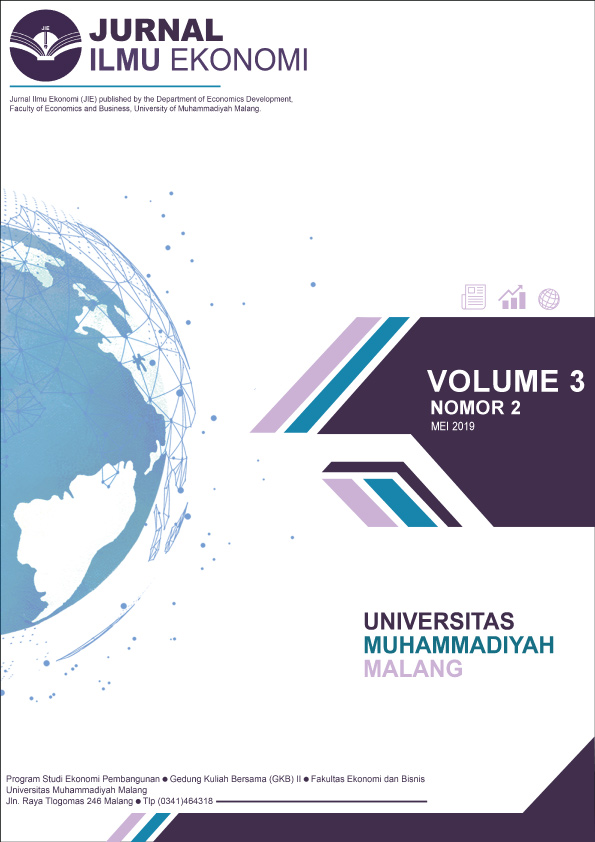ANALISIS PENGARUH MODAL DAN TENAGA KERJA TERHADAP PRODUKSI GENTENG DI DESA UREK-UREK KECAMATAN GONDANGLEGI KABUPATEN MALANG
DOI:
https://doi.org/10.22219/jie.v3i2.8244Abstract
Abstract :This study aims to determine and analyze the influence of factors of production capital and labor to the production of tile and efficiency of the production of tiles in the village Urek-urek Gondanglegi District of Malang. This study uses variables consisting of capital and labor. The the sampling technique used is Simple Random Sampling. Data collected with secondary data and primary. The analysis use are the assumptions of classical, the analysis of the regression of the liniear risk using the production Coob-Douglas, the statistics analysis and effeciency of the production of tiles. The test results of a partial to show that labor have a significant effect on the tiles. The capital didn’t have a significant effect on the tiles. Then the results of the efficiency of business production obtained figures of 2,312 the meaning of the business plate is an efficient.
Keywords:Captial, Labor, Production Results, Business efficiency.Downloads
References
Achadin, M. (2017). Analisis Faktor yang Mempengaruhi Produksi Tebu Pada Sub Sektor Perkebunan di Provinsi Jawa Timur Tahun 2011-2015. Universitas Muhammadiyah Malang.
Badan Pusat Statistik (BPS). Website BPS: https://malangkab.bps.go.id (2017)
Facrizal, R. (2016). Analisis Pengaruh Modal dan Tenaga Kerja Terhadap produksi Industri Kerajinan Kulit di Kabupaten Merauke. Ekonomi Pembangunan, 66-74.
Gaspersz, V. (2005). Ekonomi Manajerial Penerapan Konsep-Konsep Ekonomi Dalam Manajemen Bisnis Total. Jakarta: PT Gramedia Pustaka Utama.
Kurniasari, P. (2011). Analisis Efisiensi dan Faktor-faktor yang Mempengaruhi Produksi Industri Kecil Kabupaten Kendal. Universitas Diponegoro Semarang.
Lasiono, E. F. (2016). Analisis Nilai Produksi Industri Kecil di Kota Probolinggo. Universitas Muhammadiyah Malang.
Menteri Perindustrian RI, 2014, Program Restrukturisasi Mesin dan/ atau Peralatan Industri Kecil dan Industri Menengah Tahun 2014, Jakarta: Menteri Perindustrian Republik Indonesia.
Mubyarto. (1986). Pengantar Ekonomi Pertanian. LP3ES. Yogyakarta.
Muktianto, D. S. (2016). Analisis Efisiensi Produksi pada Industri Genteng di Desa Nangsri Kecamatan Kebakkramat Kabupaten Karanganyar. Universitas Sebelas Maret Surakarta.
Nayaka, K.W., Kartika, I.N. (2018). Pengaruh Modal, Tenaga Kerja dan Bahan Baku Terhadap Pendapatan Pengusaha Industri Sanggah di Kecamatan Mengwi. Ekonomi Pembangunan, 27-56.
Nuraini, I. (2013). Pengantar Ekonomi Mikro. Malang: UMM Press.
Sholikhah, M. (2017). Pengaruh Tenaga Kerja dan Modal terhadap Hasil Produksi Industri Konveksi Shafa Jaya di Tulungagung. Institut Agama Islam Negeri Tulungagung.
Nicholson. 2002. Mikro Ekonomi Intermediate dan Aplikasinya. Jakarta: Erlangga
Simanjutak, P.J. (1998). Pengantar Ekonomi Sumberdaya Manusia. Jakarta: FE UI.
Sudarman, A. (2004). Teori Ekonomi Mikro, edisi 4, Yogyakarta: BPFE UGM
Soekartawi. (2003). Teori Ekonomi Produksi dengan Pokok Bahasan analisis Cobb-Douglas. Jakarta: PT RajaGrafindo Persada.
Sulistyono, D. (2003). Analisis Fungsi Produksi Industri Kerajinan Genteng di Kecamatan Cawas Kabupaten Cawas.Universitas Sebelas Maret Surakarta.
Tambunan, T. (2002). Usaha Mikro Kecil dan Menengah di Indonesia. Jakarta: LP3ES.
Undang-Undang RI Nomor 13 Tahun 2013 Tentang Ketenagakerjaan.
Wulandari, I. A., Setiawina, N. D., & Djayastra, K. (2017). Analisis Faktor-faktor yang mempengaruhi Produksi Industri Perhiasan Logam Mulia di Kota Denpasar. Ekonomi Pembangunan, 79-108.
Downloads
Published
How to Cite
Issue
Section
License
Copyright (c) 2021 Jurnal Ilmu EKonomi JIE

This work is licensed under a Creative Commons Attribution-NonCommercial-ShareAlike 4.0 International License.
Authors who publish with this journal agree to the following terms:
- For all articles published in the JIE (Jurnal Ilmu Ekonomi), copyright is retained by the authors. Authors give permission to the publisher to announce the work with conditions. When the manuscript is accepted for publication, the authors agree to the automatic transfer of non-exclusive publishing rights to the publisher.
- Authors retain copyright and grant the journal right of first publication with the work simultaneously licensed under a Creative Commons Attribution-NonCommercial-ShareAlike 4.0 International License that allows others to share the work with an acknowledgement of the work's authorship and initial publication in this journal.
- Authors are able to enter into separate, additional contractual arrangements for the non-exclusive distribution of the journal's published version of the work (e.g., post it to an institutional repository or publish it in a book), with an acknowledgement of its initial publication in this journal.
- Authors are permitted and encouraged to post their work online (e.g., in institutional repositories or on their website) prior to and during the submission process, as it can lead to productive exchanges, as well as earlier and greater citation of published work (See The Effect of Open Access).
This is an open access article and licensed under a Creative Commons Attribution-NonCommercial-ShareAlike 4.0 International License








